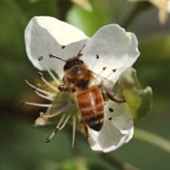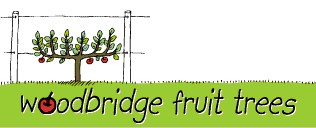No products
 View larger
View larger
Apple Cross Pollination
by Bob Magnus | © 2006 Woodbridge Fruit Trees | www.woodbridgefruittrees.com.au

As apples are so widely grown and have been so closely studied we know lots about their sex lives. Almost without exception apples need a female parent and a male pollinator. Though both male (stamens) and female (the pistil) parts occur on the one tree and even within the same blossom, apples are unable to pollinate themselves. They require pollen from another apple variety to achieve successful fertilization. We also know that bees and to a lesser extent a few other insects (beetles, moths etc) are responsible for transferring the pollen from one variety to another. A honeybee may make dozens of trips daily through the orchard in full blossom and visit hundreds of blossoms. As they visit the flowers collecting nectar and pollen to feed their brood, pollen adheres to their hairy bodies and subsequently rubs off onto the sticky tips of the pistils. When this happens, pollination is effected.
We have also observed that bees prefer to confine their flights to one group of trees so they pollinate well in hedgerows or groups of trees actually growing together. On the other hand the isolated roadside wildlings growing around here are always loaded with fruit, so the bees are not neglecting them either.
Apples are self sterile and need pollen from other apple trees to mix and maintain a rich general diversity in their offsprings. Of course we are interested in (and tempted by) the sweet and aromatic flesh surrounding the seeds and pay little attention to the seeds themselves. By discarding the seed and spreading it around we are doing our job in nature’s scheme of things and it is interesting to note that despite the best efforts of plant breeders, still many of our new varieties are the result of chance seedlings!
In the home orchard there is seldom unsatisfactory cross pollination. 3 or 4 varieties growing together will give a good overlap of flowering times and it’s more usual that apples are too prolific and set far too many fruit and have to be thinned (remove 3 of every 4 fruit if you can bear to do so), rather than the scenario in which they don’t set any fruit at all.
There is a group of apples however, known as triploids. These produce no pollen and put all their energy into producing usually big and large quantities of fruit. Among the list of triploids are Belle de Boskoop, Blenheim Orange, Bramley’s Seedling, Calville Blanc D’Hiver, Cat’s head, Gravenstein, Jonagold, Mutsu, and Ribston Pippin. They need other apple trees (diploids) to give viable pollen for fertilization and more attention should be given to their requirements.
It is not always so that varieties fruiting early in the season also flower early. Apples flower over a period of about a month from late September and there is a good overlap of flowering times to secure good cross pollination. And in the end - apples are as bound up by their sexuality and need to reproduce as we are and they want to and are busy doing it!
So if you plant 3 or 4 varieties (very early, early, mid season and late maturing) I’ll guarantee that you will not have any cross pollination problems.
This product is no longer in stock
by Bob Magnus | © 2006 Woodbridge Fruit Trees | www.woodbridgefruittrees.com.au

As apples are so widely grown and have been so closely studied we know lots about their sex lives. Almost without exception apples need a female parent and a male pollinator. Though both male (stamens) and female (the pistil) parts occur on the one tree and even within the same blossom, apples are unable to pollinate themselves. They require pollen from another apple variety to achieve successful fertilization. We also know that bees and to a lesser extent a few other insects (beetles, moths etc) are responsible for transferring the pollen from one variety to another. A honeybee may make dozens of trips daily through the orchard in full blossom and visit hundreds of blossoms. As they visit the flowers collecting nectar and pollen to feed their brood, pollen adheres to their hairy bodies and subsequently rubs off onto the sticky tips of the pistils. When this happens, pollination is effected.
We have also observed that bees prefer to confine their flights to one group of trees so they pollinate well in hedgerows or groups of trees actually growing together. On the other hand the isolated roadside wildlings growing around here are always loaded with fruit, so the bees are not neglecting them either.
Apples are self sterile and need pollen from other apple trees to mix and maintain a rich general diversity in their offsprings. Of course we are interested in (and tempted by) the sweet and aromatic flesh surrounding the seeds and pay little attention to the seeds themselves. By discarding the seed and spreading it around we are doing our job in nature’s scheme of things and it is interesting to note that despite the best efforts of plant breeders, still many of our new varieties are the result of chance seedlings!
In the home orchard there is seldom unsatisfactory cross pollination. 3 or 4 varieties growing together will give a good overlap of flowering times and it’s more usual that apples are too prolific and set far too many fruit and have to be thinned (remove 3 of every 4 fruit if you can bear to do so), rather than the scenario in which they don’t set any fruit at all.
There is a group of apples however, known as triploids. These produce no pollen and put all their energy into producing usually big and large quantities of fruit. Among the list of triploids are Belle de Boskoop, Blenheim Orange, Bramley’s Seedling, Calville Blanc D’Hiver, Cat’s head, Gravenstein, Jonagold, Mutsu, and Ribston Pippin. They need other apple trees (diploids) to give viable pollen for fertilization and more attention should be given to their requirements.
It is not always so that varieties fruiting early in the season also flower early. Apples flower over a period of about a month from late September and there is a good overlap of flowering times to secure good cross pollination. And in the end - apples are as bound up by their sexuality and need to reproduce as we are and they want to and are busy doing it!
So if you plant 3 or 4 varieties (very early, early, mid season and late maturing) I’ll guarantee that you will not have any cross pollination problems.
Reviews
No customer reviews for the moment.

